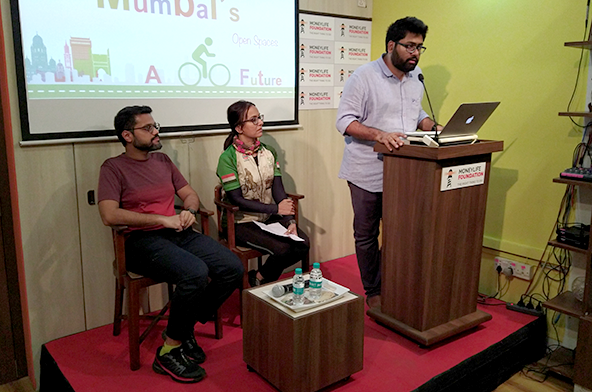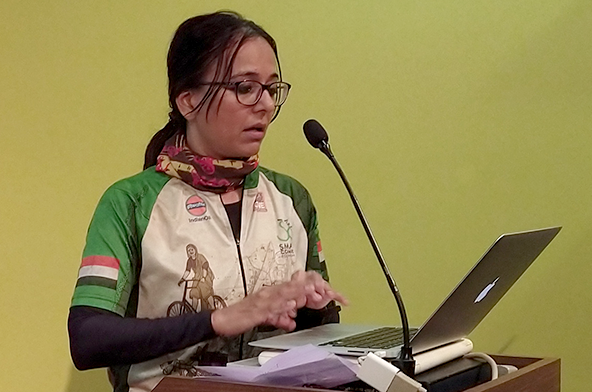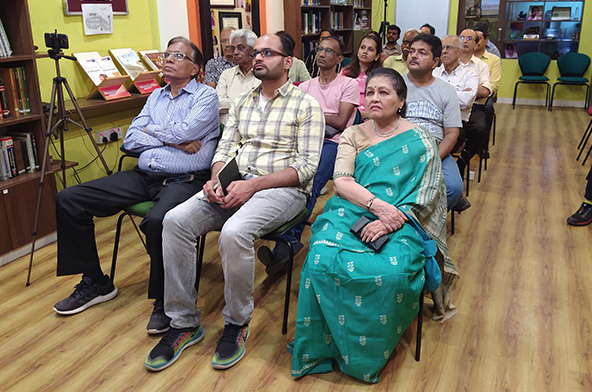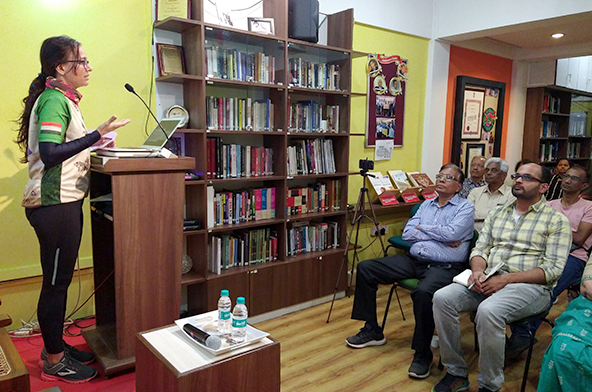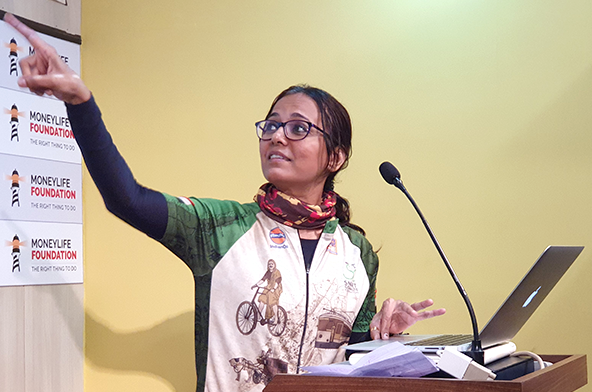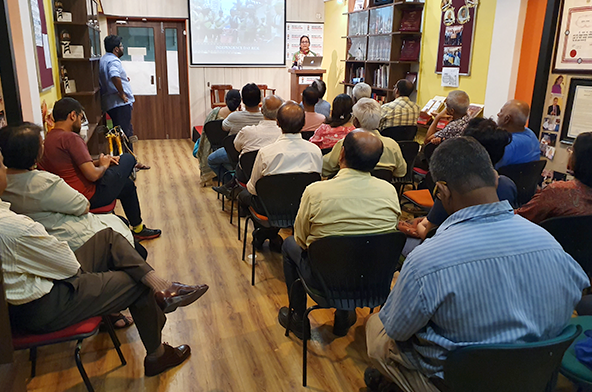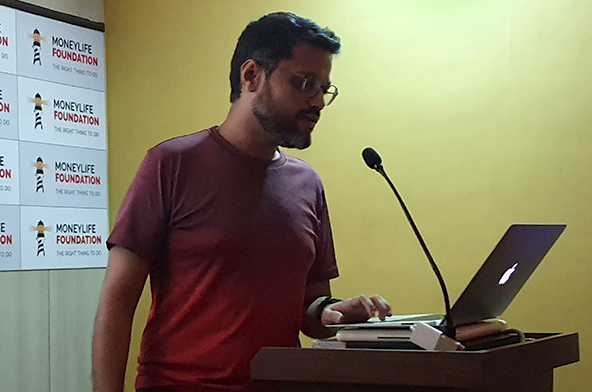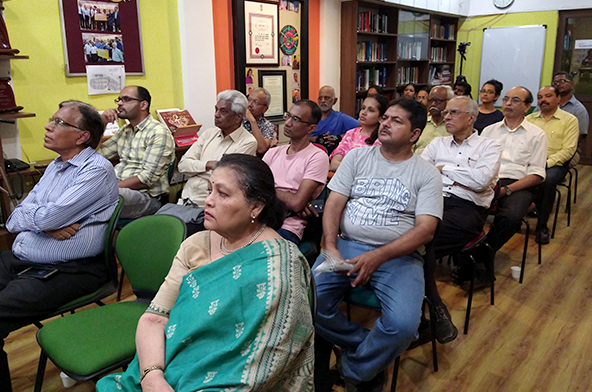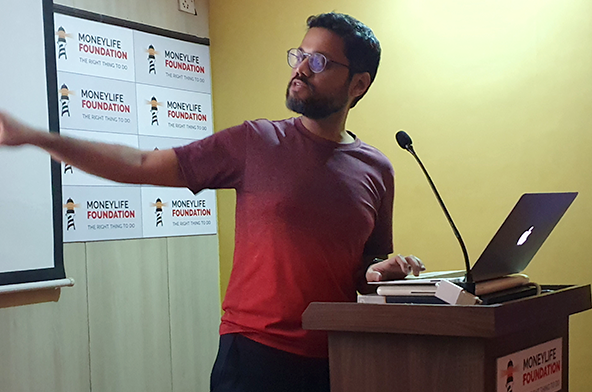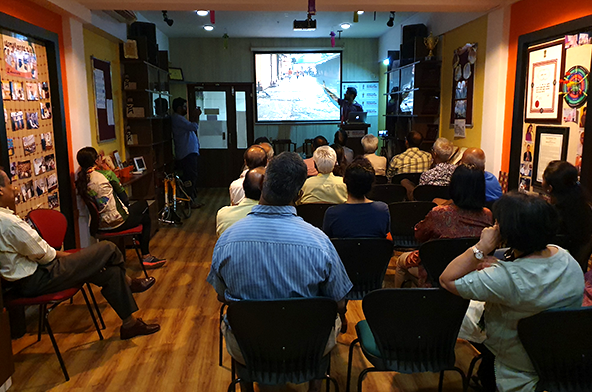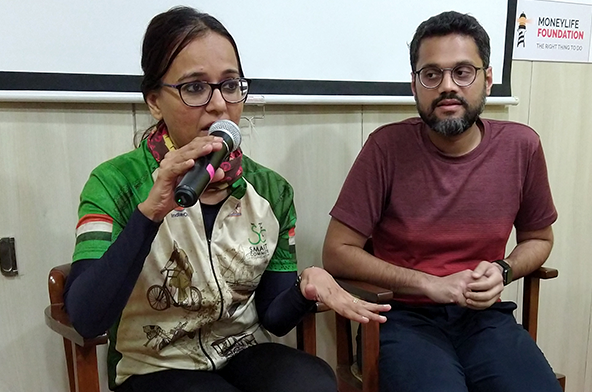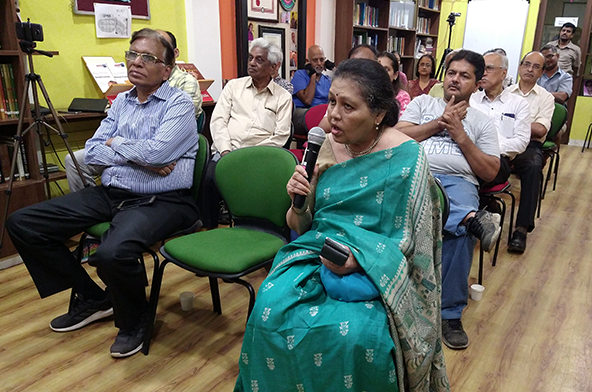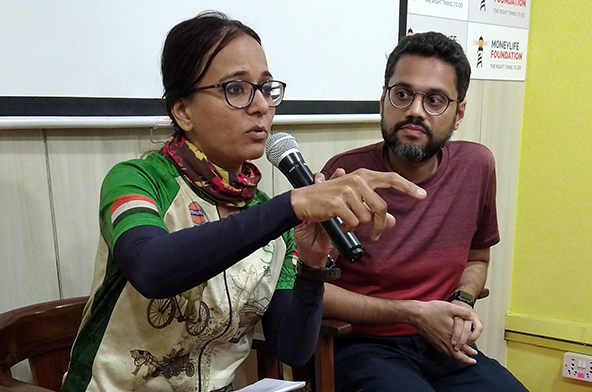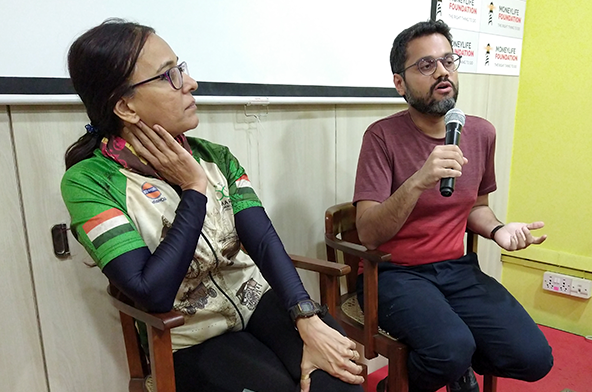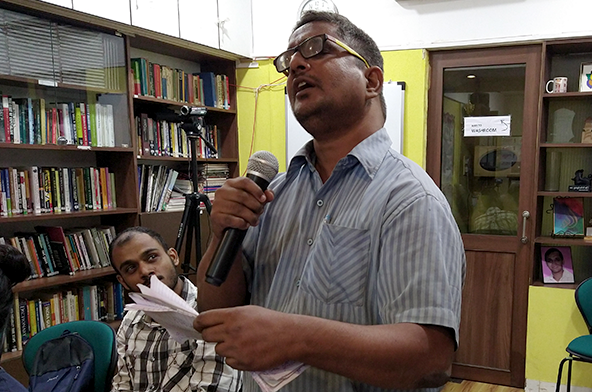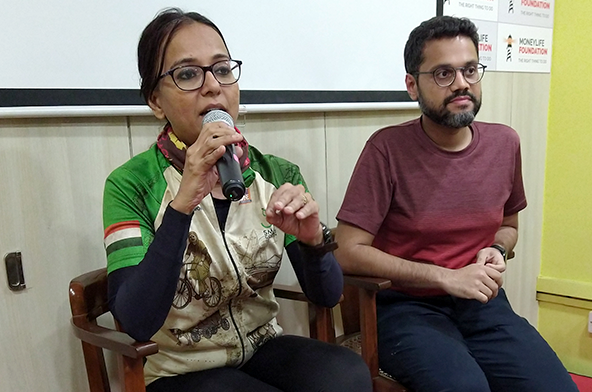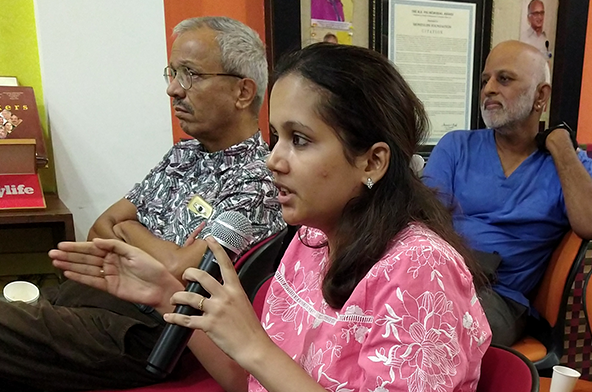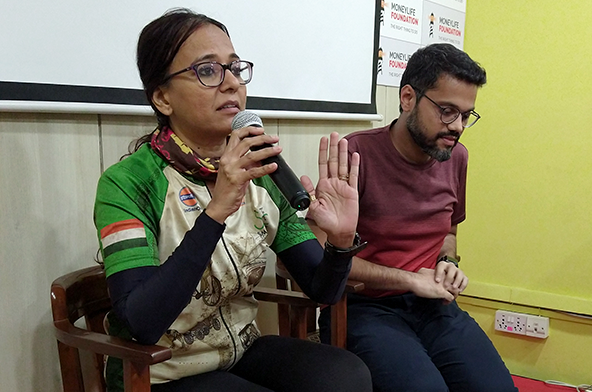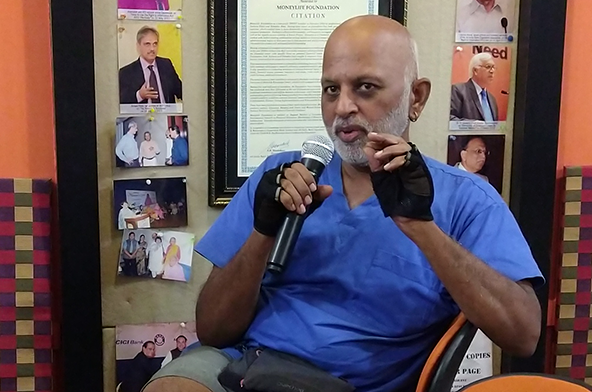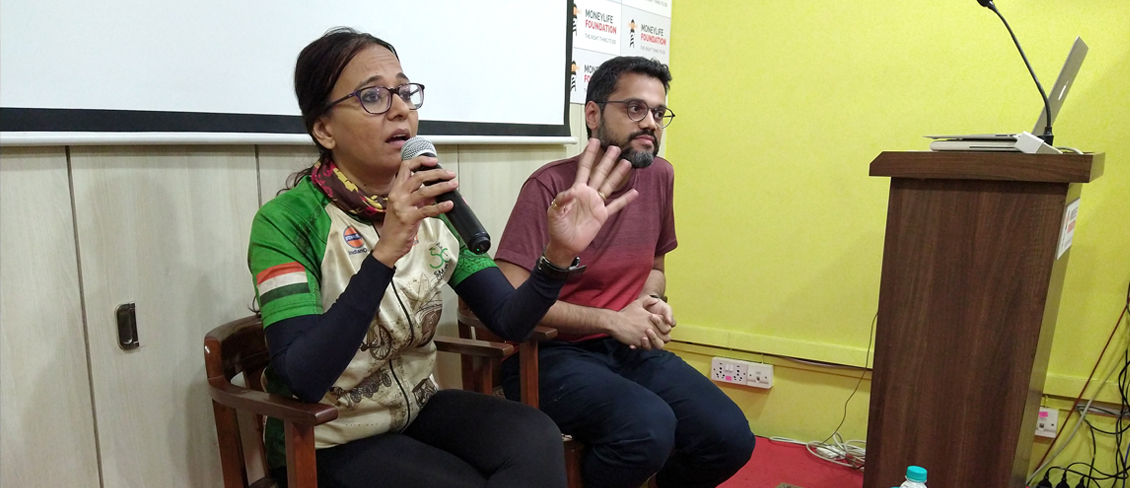
Although it may not seem like it, even with the Metro constructions and other ongoing projects Mumbai still has a lot of open space. It is just not being utilised in an efficient manner. Even with availability of space, Mumbaikars have not been able to enjoy a few basic facilities such as pedestrian safety and well designed footpaths. With this in mind, Moneylife Foundation had invited architect Pranav Naik, founder of Studio Pomegranate to share the successes he has had working on projects for private companies and many other interested parties.
One such project involved financial services firm Motilal Oswal in improving the open space around their office in Prabhadevi, Mumbai. They were interested in improving some of their space and get some publicity as well, because they are paying for it and also achieving their goals for Corporate Social Responsibility for tax cuts etc. said Pranav.
At the most basic level, this project involved improving the pedestrian walkways around the office and placing trees or lights at the appropriate places, essentially maximising the available space.
Pranav explained that the Brihanmumbai Municipal Corporation (BMC) is happy to be involved in such projects as well because it is in a way free publicity for them as well. The entire process of beautifying and making efficient use of the open space around Motilal Oswal s office, involved different parties which included, professional RTI activists, politicians, local mafia and other Municipal Corporation of Greater Mumbai (MCGM) departments who want to come and extort some sums of money from you anyway.
In his talk, Pranav gave several examples comparing Mumbai s streets of the past with those today. The surface of Bombay s streets was for 100 years paved with limestone from Shahbad. The 21st century however saw the proliferation of the interlocking paver blocks in the city. Good limestone was removed, and replaced with poor quality uneven concrete.
To solve the issue outside of Motilal Oswal, the limestone was brought back, with a slight change in the format - a 7x7 size and an increased thickness. According to Pranav, placed on a levelling layer of concrete, it makes the walking surface free of potholes, kinks, and is virtually indestructible. The stone is not treated but is set in with 6mm grooves, 6mm deep.
Speaking on another project which they took up under the Tulsi pipe road in Lower Parel, Mumbai, Pranav reiterated how there was an interested party in this case as well but instead of a company, this time they were the local public. There was also additional interest from the local companies from the area - Phoenix, Lodha, HDFC bank etc.
This particular area is plagued with every kind of establishment on the road with insufficient infrastructure and is over saturated. As expected, pedestrians are most affected by this situation as they have to squeeze through leftover pockets, stumble on uneven or non-existent footpaths.
Studio Pomegranate started work on this project in March 2016 with a thorough study of the area. A sample count of vehicles, interviews, visual inspections, and measurements were taken at every junction, level change, crossing, and physical divisions. Observations were noted, and solutions brainstormed in conjunction with municipal officers, traffic police, and other stakeholders.
Pranav explained that part of the solution calls for increasing pedestrian crossings, making existing crossings safe, accessible, adding public toilets, and dustbins. Further design strategies made in conjunction with the traffic police include changing some U-turns, tweaking traffic signal locations, and adding traffic-calming measures. Making the space easily walk able, and instilling a sense of safety.
The idea was, let it be an open space. Let the people do whatever they want, explained Pranav. Emphasising the benefits, he reiterated how people can now wait, listen to music, play cricket and have a good time all simply because of open spaces. He also stressed that there have been no issues of vandalism in the area.
Shockingly, the cost of doing such projects is well within the budget of the BMC, according to Pranav. He explained, Mumbai has 2000 kms of road network, that s 4000 kms of footpath. Assuming the cost the Studio Pomegranate incurred in repairing the footpath in our project, the total cost of fixing all the footpaths in Mumbai would be around Rs6000 crores. This is only 10% of the BMC budget in 10 year s time.
In his third example Pranav shared Studio Pomegrante s work on the Nepean Sea Road. In this area there is a lack of pedestrian infrastructure, leading to confusion, and a dangerous walking environment. The lanes are 4m wide, while cars and buses are all less than 3m wide which leads to inordinate amount of space for vehicles, and a shortage of space for non-motorised users, and pedestrians.
This area also has BEST bus stops that are poorly designed as they occupy entire footpaths, forcing pedestrians to walk on the road. Further issues in the region were taxi stands not having lanes, and occupying road space as well as vehicles being given priority at all junctions, leading to unsafe crossings for pedestrians, while also being confusing.
Pranav shared some of the solutions which have been proposed to be implemented at the Nepean sea junction. They are thinking of having sheltered crossings at appropriate locations and moving the BEST bus stop to the middle of the junction. This way, the traffic is streamlined and more space is available for pedestrians.
Pranav hopes that the work his company is doing is in a way an eye opener for the public and perhaps for the BMC as well, to bring about important changes for the city.
Bicycles are the Way Forward for a Healthier and Sustainable Mumbai
"Even though India is the second largest manufacturer of bicycles in the world, Mumbai is still ranked 97th when it comes to cycling," said Firoza Suresh, a cycling enthusiast and director of the Smart Commute Foundation (SCF). She was speaking at an event organised by Moneylife Foundation on making utilising Mumbai's open spaces and making it more cycling friendly.
We all know about the health benefits of taking a bicycle to work or for covering short distances. It also an economical and eco-friendly option compared to the traditional 2 or 4 wheeler. But as Firoza explained in her talk, the biggest deterrent for people in adapting to a bicycle for transportation, "unlike running or walking, where you just wear your shoes and travel, for a bicycle you have to purchase or already own the vehicle."
Firoza, through SCF, has pledged to promote a healthier, greener and happier city by encouraging people to adopt cycling as a means of daily commute. She shared that since it's inception in 2012, SCF has taken part in various cycling initiatives in the city such as #cycle2work, #mecyclerider and Get Cycloned - The Smart Commute Way. One of their many goals is to convert 50% of a Mumbai's population to bicycle users by 2030.
Using herself as an example, Firoza explained that "A bicycle as a vehicle is very unique, it acts as a fitness machine - people who just want to go to nearby locations can ride the bicycle and come back; people use it to commute - cycle to work, I even take it to meetings and conferences." In fact, she had also come to the event riding her bicycle from Juhu.
Firoza is also the bicycle Mayor of Mumbai and there are a total of 41 such mayors in India thus far. This idea of a bicycle mayor comes from a social enterprise from Amsterdam called BYCS, that works to transform cities to make them more environmentally friendly. Using Amsterdam as an example, Firoza explained how the city had completely transformed over a period of 30 years from a car centric model to a bicycling and pedestrian friendly city. She noted, "the change did not happen overnight and in fact involved long term efforts from both the public and the government."
To achieve the same in Mumbai will require similar sustained efforts from the public. Firoza hopes to increase ridership in Mumbai to 1 lakh by 2023 and in turn force authorities to "build better facilities - cycle stands, tracks, pothole free roads and better urban infrastructure".
"Mumbai is blessed to be a very linear city and the task of converting the population to cycling should not be difficult. Since the last 50-60 years Mumbai has always had the 'invisible' cyclists - dabbawalas, istriwalas etc. They have already created an invisible cycling track for us" Firoza explained.
Answering the concerns of many on whether cyclists would be safe travelling on Mumbai's pothole ridden or traffic congested roads, Firoza said " I feel cushioned on the road. I don't feel threatened by a bus driver or a car driver. Morever, there is a certain amount of respect when other drivers see you cycling with a helmet on."
SCF is currently working with government bodies and cycling communities to establish cycling tracks under existing Metro lines. The idea is to utilise the existing space in the median under a metro as a dedicated bicycle track. Firoza believes this to be a positive step towards making Mumbai more bicycle friendly.


